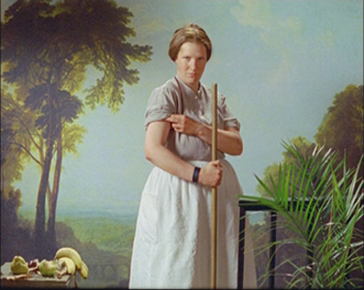
Pauline Boudry was born in Lausanne (CH) and Renate Lorenz was born in Bonne (DE). They live and work in Berlin (DE)

2007
Installation. Film 16 mm transferred to DVD, colour, sound, 13 photographs of Hannah Cullwick
Chaque photographie : 6 x 21 cm (avec cadre)
Durée : 13'
Year of Purchase: 2011
Hannah Cullwick not only cleaned from early in the morning to late in the evening in various households, she also produced a series of remarkable staged photographs, numerous diaries, and letters. These materials present her strength, her muscles, and her big, dirty hands: embodiments of her gender that were obviously directly connected with her working practices and which she was very proud of. Hannah Cullwick’s portraits and self-portraits, which show her not only as a domestic servant, but also in “class-drag” or “ethnic drag”, were part of a sadomasochist relationship that she had with Arthut Munby, a man from the bourgeois class.
Interestingly, it were the elements of her hard work in the households that provided the material for their shared SM scenes. The work that Cullwick carried out as a domestic servant was later restaged together with Munby in their meetings in his home.
Cullwick depicted herself as Munbys slave, she wore a slave band on her wrist that she never took off and a chain on her neck whose key only Munby possessed. She called him “massa”, a name which, just like slave, reminds of the colonial power of the British Empire.
The crossings of social positions that she stages in the photographs – which show her as a bourgeois woman, as a young bourgeois man, or as a slave in blackface – partly also play a role in Cullwick’s everyday life, for instance when she travelled with Arthur Munby in “bourgeois drag”.
The photographs can be understood as a technology to control these crossings, or to reflect on the great efforts and constant deliberation that were connected to them. The film Normal Work asks whether the crossings of social hierarchies of class, gender and “race” that Hannah Cullwick staged and that she obviously desired have today become generalized into a paradoxical requirement in the field of labor.
In the film, we watch the performer Werner Hirsch/Hannah Cullwick attempt to imitate Hannah Cullwick’s poses as precisely as possible. Werner Hirsch/Hannah Cullwick orients him/herself to his/her memory, to a mirror, or to a “model” that is not in the image, or to instructions that are called out by him/her, from outside of the frame. Since two different historical moments (Victorian times and the present day) and two places of expression meet each other in the film, contradictory references arise. The historical photographs are placed in the context of contemporary drag performances and reworking through gender binarity. Taken in the other direction, contemporary performances are placed next to a historical predecessor, in which the relations between sexuality and work were negociated.
P. Boudry & R. Lorenz